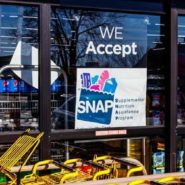AARP Hearing Center
Millions of Seniors Rely on SNAP for Food
By Olivia Dean, Lynda Flowers, July 16, 2018 11:16 AM

SNAP—or the Supplemental Nutrition Assistance Program—is an essential safety net program for millions of older adults who would otherwise be at risk for hunger and hunger-related health problems. In fact, 22 percent of households receiving SNAP (nearly 4.7 million) have at least one adult age 60 or older.
As the U.S. population ages and SNAP faces the prospect of changes that could affect the future of the program, it becomes all the more important to examine the dynamics around this large segment of SNAP users. AARP Public Policy Institute’s recently released fact sheet takes a closer look at SNAP households with older adults.
SNAP Participants and Their Benefits
Individual and household-level SNAP eligibility rules for the 60+ population are complex and frequently misunderstood. Under general SNAP rules, individuals must meet income and asset requirements and comply with work requirements. However, older adults qualify under more generous income rules than younger populations, and they are exempt from work requirements.
The vast majority of senior SNAP recipients live alone. Over 80 percent of households with at least one adult age 60 or older are single-person households. These individuals may be particularly vulnerable if they are disabled or in poor health, which could make it difficult for them to buy or prepare food.
Average SNAP benefits vary widely by location. In 2016, a SNAP household with at least one senior received an average benefit of $124 per month—though the range was notably wide, from $72 in Arkansas to $379 in Guam. Why the big difference? Household size certainly impacts benefit levels. For example, the average size of a SNAP household in Arkansas was 1.3 people, compared to an average size of 2.1 people in Guam. In addition, because of the high cost of living in Guam, Alaska, Hawaii, and the Virgin Islands, these states and territories have different income eligibility requirements and benefit maximums.
Underused and Underestimated
SNAP helps older adults afford nutritious food, which has the potential to improve their health status. Yet SNAP participation is remarkably low among seniors, with only 42 percent of those eligible actually enrolled. Possible reasons for this include stigma around receipt of government benefits, confusion over the complex eligibility requirements, burdensome application processes, and simply not knowing the program exists.
The number of SNAP-eligible older adults ages 60 and older will likely increase in coming years as the U.S. population ages. Along with efforts to reduce barriers to SNAP participation, further research to better understand SNAP’s impact on the health and financial security of older adults will become increasingly important as policymakers consider potential changes to the program ( 1 ,2).
** For more data on SNAP households with older adults ages 60+ as well as ages 50-59, check out our fact sheet here . **

Olivia Dean is a policy analyst with the AARP Public Policy Institute. Her work focuses on public health, health disparities, and private coverage issues.

Lynda Flowers is a senior strategic policy adviser with the AARP Public Policy Institute, specializing in Medicaid issues, health disparities and public health.































































